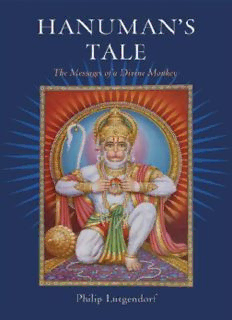
Hanuman's Tale: The Messages of a Divine Monkey PDF
Preview Hanuman's Tale: The Messages of a Divine Monkey
Hanuman’s Tale A Kannada-languageposter showsHanuman’s body inscribed withdevotional poems;late twentiethcentury Hanuman’s Tale The Messages of a Divine Monkey philip lutgendorf 1 2007 3 OxfordUniversityPress,Inc.,publishesworksthatfurther OxfordUniversity’sobjectiveofexcellence inresearch,scholarship,andeducation. Oxford NewYork Auckland CapeTown DaresSalaam HongKong Karachi KualaLumpur Madrid Melbourne MexicoCity Nairobi NewDelhi Shanghai Taipei Toronto Withofficesin Argentina Austria Brazil Chile CzechRepublic France Greece Guatemala Hungary Italy Japan Poland Portugal Singapore SouthKorea Switzerland Thailand Turkey Ukraine Vietnam Copyright#2007by OxfordUniversity Press,Inc. PublishedbyOxfordUniversityPress,Inc. 198MadisonAvenue,NewYork,NewYork10016 www.oup.com OxfordisaregisteredtrademarkofOxfordUniversityPress. Allrightsreserved.Nopartofthispublicationmaybereproduced, storedinaretrievalsystem,ortransmitted,inanyformorbyanymeans, electronic,mechanical,photocopying,recording,orotherwise, withoutthepriorpermissionofOxfordUniversityPress. LibraryofCongressCataloging-in-PublicationData Lutgendorf,Philip. Hanuman’stale:themessagesofadivinemonkey/PhilipLutgendorf. p.cm. Includesbibliographicalreferencesandindex. ISBN-13978-0-19-530921-8;978-0-19-530922-5(pbk.) ISBN0-19-530921-9;0-19-530922-7(pbk.) 1. Hanuman(Hindudeity). 2. Hanuman(Hindudeity)inliterature. 3. Hinduliterature,Hindi—Historyandcriticism. I. Title. BL1225.H3L872006 294.5'2113—dc22 2006045391 9 8 7 6 5 4 3 2 1 PrintedintheUnitedStatesofAmerica onacid-freepaper In remembrance of Eruch, disciple of Meher Baba; and for Susan, Mira, and Claire My heart, Lord, holds this conviction: Greater than Rama is Rama’s servant. ——Tulsidas (R¯amcaritm¯anas 7.120.16) Preface and Prashasti* Thisbookproject,liketheposteriorappendageofitsbelovedsubject, has grown longer andlonger and hashungaround for aconsider- able time. Theinspiration forit first emergedduringmy research, mainlyintheBanarasregionin1982–84,ontheperformanceofthe R¯amcaritm¯anas, the popular Hindiretelling ofthe tale ofRama and Sita by the sixteenth-century poet-saint Tulsidas. Thisresearch led not only to my book TheLife ofa Text (1991) but to my growing realization that, in the experience andpractice of many people, the most vibrant and endearing characterin the story wasn’t Rama, but ratherHanuman.Giventhat scholarly literatureseemed virtually unawareof this (acircumstance I discussfurther in chapter 1), I resolvedto write abook thatwould give Rama’s simian associate the prominencehe had longachieved in everyday life. Initial research was carried out under a senior research fellow- shipfromtheAmericanInstituteofIndianStudiesin1989–90. DuringthisyearIwasfrequentlyonthemove,collectingimages, interviews,andpopularandscholarlypublicationsfromsitesinNorth, central,andSouthIndia.ThematerialsIbroughtbacktotheUnited Stateskeptmebusyforyears,andkeptgrowingasImadereturn visitstoIndia(severalwithsupportfromtheUniversityofIowa)and asfriendsaroundtheworldsentmebooks,newsclippings,posters, and(morerecently)e-mailmessagesandWebsiteaddressesfeaturing everyone’sfavoritemonkey.Imadesignificantprogressinorganiz- ingandinterpretingmy‘‘Hanumanarchive’’duringsummervaca- tionsandtwosemestersofdevelopmentalleavefundedbythe * Pra(cid:1)ssasti(Sanskrit):theeulogizingofpatronsandbenefactors. viii preface and prashasti university,includingoneatitsObermannInstituteforAdvancedStudies.An outlineforabookofsevenchapters(reflecting,byhappycoincidence,theusual number of Ramayana subbooks) emerged early on, then it too unavoidably grew: Hanuman, itbecame clear, would requireeight chapters, atleast—and though much has been omitted, I had to stop somewhere! The project was slowedbyseveraltermsasadepartmentchairmanandbymanyinvitationsto write conference papers and essays. None of the half dozen articles on Ha- numan that I have published during the past decade correspond exactly to chapters in this book, and some of them contain additional material that is beyonditsscope.However,portionsofseveralofthemareincorporatedhere, andtherewassimplynootherwaytobeginchapter1thanwitharevisedand updated version of the opening section of my first such essay (Lutgendorf 1994b),though I quickly depart from its content. I am grateful to the editors ofContributionstoIndianSociology,HistoryofReligions,InternationalJournalof HinduStudies,Manushi,andReligion,andtoOxfordUniversityPressandSage Publications for their understanding regarding these edited excerpts. Com- pletionofthefirstdraftofthemanuscriptduring2002–03wasmadepossible throughthegenerosityoftheJohnSimonGuggenheimMemorialFoundation andtheUniversityofIowa’sCollegeofLiberalArtsandSciences.Iespecially thank Deans Linda Maxson and Rau´l Curto for their encouragement of my researchduringaperiodwhenouruniversity(likemostpublicuniversitiesin theUnitedStates)wassufferingseverebudgetreductions.Additionalsupport from the university’s vice president for research has helped underwrite the illustration of this volume. I also thank my editor, Theo Calderara of Oxford University Press, for his enthusiasm for this project, and the press’s two anonymous readers for their corrections and good advice on reigning in my prolixity. Production editor Gwen Colvin and copyeditor Norma McClemore providedfurthervaluedassistance. I can never adequately thank, or even properly catalog, all the friends, colleagues, and devotees of Hanuman (the latter category not excluding the former two) who helped me in my work over the years. But I cannot fail to mention, in Banaras, Ramji Pandey of Ramnagar, Chandradharprasad Nara- yan Singh (‘‘Bhanuji’’) of Nagwa, and Ramnarayan Shukla and Veerbhadra MishraoftheSankatMochantemple;RatneshPathakguidedmeonawalking tourofHanumanshrinesinseveralneighborhoods.InAyodhya,NrityaGopal Das provided hospitality, and I greatly benefited from the insights of Pandit RamkumarDasand(afterhisdeath)thoseofhisdiscipleSacchidanandDasof ManiParvat.ItwasalsoinAyodhyathatIfirstmetthegreatRamayanascholar Bhagavati Prasad Singh of Gorakhpur University, whose work I have long admired.Webecamefriends,andIwasfortunatetorecordalastinterviewwith him only a few days before his death in Vrindaban in January 1994. Also in Vrindaban,IwasaccommodatedandassistedbyShrivatsGoswamiandthelate Asim Krishna Das. In Rewa, Madhya Pradesh, I was hosted and guided by Gokaran and Urmila Shrivastava. In Pune, I was given a memorable tour of Maruti shrines by Sudhir Wagmare and further assisted by Jeffrey Brackett and Anne Feldhaus. In Bangalore, Girish Karnad and Saraswati Ganapathy preface and prashasti ix providedextraordinaryhospitalitytomyfamilyforamonth,andmyresearchin Mysore and elsewhere in Karnataka State owed much to the energetic assis- tance of M. S. Nagaraja Rao, former director general of the Archaeological SurveyofIndia.AtHampi,Iwasguidedto(whatmanyconsider)Hanuman’s birthplace and other important sites by archeologists John Fritz and John (‘‘Kim’’) Malville. Whenever I passed through Delhi I was warmly welcomed and assisted by the staff of the American Institute of Indian Studies and by its director general, Pradeep Mehendiratta, and I also received help from Jagannath Das of the Connaught Place Hanuman temple and from the re- sourcefulKailashJha.JyotindraJain,whoisnowdeanoftheSchoolofArtand Aesthetics at Jawaharlal Nehru University but was previously director of the National Handlooms and Handicrafts Museum, gave me much appreciated help. I spent two pleasant afternoons in the Hanuman Museum at Gurgaon created by K. C. Aryan and his children, Subhashini and B. N. Aryan, who continuedtoassistmeaftertheirfather’sdeath.OnseveralvisitstoTaos,New Mexico, I was warmly received by Dwarka Bonner, Patrick Finn, and other membersoftheNeemKaroliBabaAshramcommunity. Ithasbeenmygoodfortunetodomuchofthefinalwritingandeditingof this book in a peaceful cabin on the Front Range of the Rocky Mountains. I thankthefriendsinBoulder,Colorado,andenvironswhohavewelcomedme andmyfamilytothisarea:DorothyTerner,SusanOsborne,AlanBoles,Dennis andBethMcGilvray,CraigCameron,StanleyandConnieHeginbotham,Tom Coburn,andJimandAudreyBenedict.Thenearby(and,forme,aptlynamed) Indian Peaks, with their majestic pinnacles and shining snowfields, have in- spired me and reminded me of my happy sojourns in the Himalayas and of Hanuman’sabidingpresencethere. Toattempttocitealltheacademiccolleagueswhohaveguided,chided,and encouragedmeovertheyearsconcerningthisseeminglyendlessprojectwould easilyresultinanotherHanum¯ayana(seechapter3foranexplanationofthis neologism),aswellassomethingofacatalogofSouthAsiascholarsworldwide; the publications of some of those who are noted here are of course cited at appropriate places. I apologize in advance to those whose names, for reasons of space or faulty memory, I do not list here. But I cannot fail to mention JosephAlter,MandakrantaBose,JeffreyBrackett,WinandCallewaert,Mathieu Claveyrolas, Paul Courtright, Wendy Doniger, Daniel Gold, Robert Gold- man and Sally Sutherland Goldman, Linda Hess, Istva´n Keul, Nita Kumar, Kirin Narayan, Antti Pakaslahti, William Pinch, Sheldon Pollock, Sumathy Ramaswami, V. Narayana Rao, Peter van der Veer, Anila Verghese, Susan S. Wadley,PhillipWagoner,andDavidGordonWhite.H.DanielSmith,profes- soremeritusatSyracuseUniversity,generouslygavemeaccesstohiscollection ofHanumanposters,asdidPatriciaUberoiofDelhiUniversity.Photographer andHanumandevoteeMartinBradingsharedpicturesoftemplemurtis,and Carroll Molton and Charles Southwick shared their research on Indian pri- mates. I especially thank Ann Grodzins Gold, David Haberman, and John StrattonHawley,who(inadditiontootherassistance)wroteinsupportofmy applicationtotheGuggenheimFoundation.
Description: